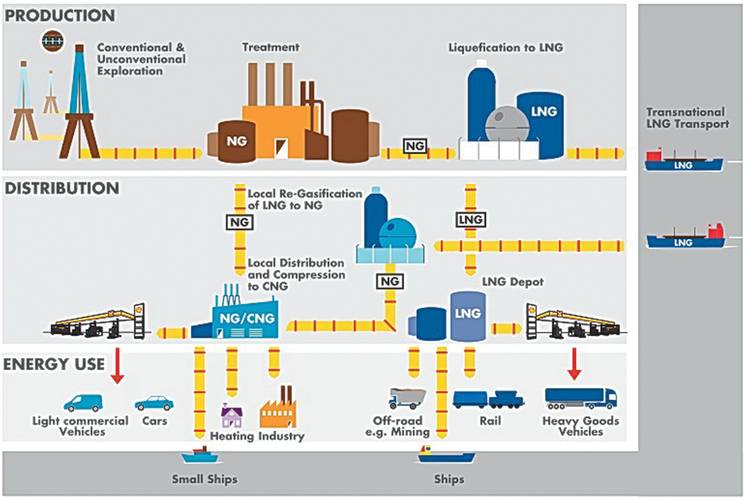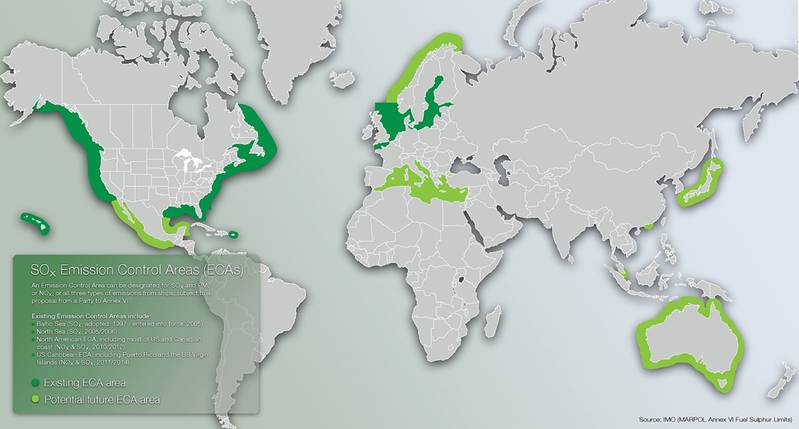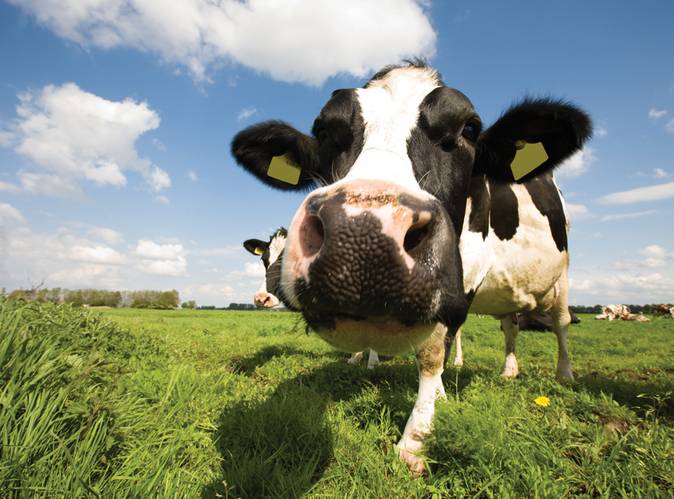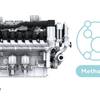Is Internal Combustion Engine Methane Slip Harmful to the Environment?
Tighter regulations on exhaust emissions are prompting rapid change within the global shipping industry. Orders for scrubber systems have soared higher than before, suppliers of emissions monitoring software are rapidly taking increasing orders, and the market for natural gas-powered engines continues to break new ground.
Choosing the most cost-effective way to reduce exhaust emissions is vital for the industry. Regulations for Emissions Control Areas (ECAs) are now enforced across many countries and there are further designation zones under discussion. Also, the maximum sulfur content in fuel burnt in such designated areas will drop from 1% to 0.1% very shortly. This change will be wide-reaching; around 80-90% of merchant vessels will enter a SECA zone (Sulfur Emission Control Area) in their lifetime. What’s more, failing to adapt to the change could be expensive; the cost of low-sulfur fuel that is compliant with regulation is stated to be up to 30% higher than the price of standard bunker fuel.
Gas engines are expected as a strong substitute for diesel engines in marine fields, where strict emission regulations have been introduced and will become more stricter.
Thanks to the sulfur-free and low-carbon features of natural gas, gas engines emit much less CO2 and particulate matter than marine diesel burning heavy fuel oil.
The premixed lean-burn gas and partly dual-fuel engines, however, suffer one massive flaw: it is the methane slip, which substantially means the unburned methane emitted into exhaust ports and the atmosphere. And any gas which is not combusted is a highly potent greenhouse gas, with an effect that offsets the gain from reduced CO2.
Environmental Aspect of Natural Gas
Natural Gas is often highlighted as the cleanest fossil fuel alternative. When compared to diesel oil used for piston engines, natural gas has the following potential benefits / reduced emissions as opposed to conventional diesel engines.
It is important to note that the gas engines available today can be divided in two main categories:
• Dual fuel engines
(e.g. Wärtsilä, MAN)
• Lean-burn gas engine
(e.g. Rolls-Royce, Mitsubishi)
The different engines and engine - propulsion arrangements have varying characteristics and levels of efficiency.
The true reduction of greenhouse gas emissions in each individual case will of course depend on the total efficiency of the chosen alternative. It should be noted here, however, that methane slip, will negatively influence the reduction of greenhouse gases significantly, and in worst cases eliminate the gains from CO2 reductions. In consideration of the fact that CH4 is about 20-25 times more powerful than CO2 as a greenhouse gas during a 100 year time span, release of even small volumes of methane easily spoils the potential gains.
Available Methane
Apart from gas fields, an alternative method of obtaining methane is via biogas generated by the fermentation of organic matter including manure, wastewater sludge, municipal solid waste (including landfills) or any other biodegradable feedstock, under anaerobic conditions. Rice fields also generate large amounts of methane during plant growth. Methane hydrates/clathrates (ice-like combinations of methane and water on the sea floor, found in vast quantities) are a potential future source of methane. Cattle belch methane accounts for 16% of the world’s annual methane emissions to the atmosphere. One study reported that the livestock sector in general (primarily cattle, chickens, and pigs) produces 37% of all human-induced methane. A more recent study found that at a conservative estimate, at least 51% of global greenhouse gas emissions were attributable to the lifecycle and supply chain of livestock products, meaning all meat, dairy and by-products, and their transportation.
Compared to this enormous amount of direct methane emission, the contribution to total world greenhouse gas emission of marine engines is very minute.
Methane Slip Reduction
In connection with gas engines, while NOx emissions are negligible, emissions of unburnt methane are a subject of increasing attention for all mayor engine manufacturer
“The amount of unburnt gas following combustion in a Wärtsilä gas engine is small,” said Ingemar Nylund, Director Research & Development. “It is trapped in clearances in the combustion chamber (piston rings, the anti-polishing ring, valve seats etc.) where the air-fuel ratio means that the gas does not burn during combustion but is released unburnt with exhaust gases during cylinder scavenging. We ensure that methane slip is minimized in our engines in two ways,” he continued. “By continuous development of the combustion chamber technology to improve the combustion process, new Wärtsilä products have to be the reference in terms of engine efficiency, output and greenhouse gas emissions, and by the oxidation of unburnt methane using a catalyst. And with our latest development, our low-pressure 2-stroke engine, the methane slip is almost negligible.
The “methane slip” inherent in the RT-flex 50DF engine is less than what is found in the equivalent 4-stroke engine and still results in 25% less equivalent CO2 emissions, because the combustion has much more time to burn more completely, which is not the case in 4-stroke engines. On top of this: the RT-flex DF engines have the potential to further reduce the methane slip by further developments, which means: ‘Direct’ methane slip can be avoided by correct gas admission valve timing, the use of pre-chamber technology to have complete combustion and an optimized combustion space to avoid ‘dead volumes. This well-proven technology is commonly featured in Wärtsilä solutions packages and we’re working hard to further reduce its size and cost.”
And well-known engine manufacturer Rolls-Royce claims to have lean-burn 4-stroke gas engines with very small amounts of methane slip in the range of appr. 3-4 g/kWh. But, nevertheless, as Tobias Haack, Sales Manager, said: “we are working on this to reduce this amount because it is unburned fuel – and unburned fuel means higher fuel consumption and that increases operation costs.” According to the company, it is focussing on extremely close control of combustion in every cylinder at all times, the design of the combustion chamber using the latest computer aided design tools and optimised turbo charging. MAN Diesel & Turbo explains its high pressure 2-stroke engines concept does not have any methane slip.
The ME-GI concept is based on direct gas injection with the engine operated as a conventional diesel engine. Thus, no gas is present during the compression stroke or scavenging period, minimizing methane slip to a level comparable to operation on conventional liquid fuel. Recent tests of ME-GI engines have revealed a measured methane slip in the order of 0.2 g/kWh, independent of engine load. This slip is 20-40 times lower in comparison to the methane slip recorded for the most modern, state-of-the-art, dual-fuel engines.
The global warming potential (GWP) of methane is 72 times as high as CO2 over a 20 year time interval. Thus, when calculating total GWP, in addition to CO2, CH4 must be considered as well. Taking the methane slip of the ME-GI engine into account, the total GWP is still significantly lower than normal fuel-oil operation, approximately 17-20% lower. But it is not only the combustion engine, also in the supply chain from the terminal all the way to their combustion in the engine climate change emissions may be formed (gas leaks = methane slip). Here, the escape of methane is of specific importance by means not only of gas leaks but also of the methane slip of pipe connection, couplings etc. This is a loss of usuable energy which must be avoided.
It is without doubt that the very large amount of all human-induced methane (primarily cattle, chickens, pigs, etc.), and in addition naturally existing methane on earth, can hardly be reduced. But it is in our hands to reduce possible methane slips in combustion engines and not to forget the supply chain, with all technical possibilities we have.
Engine manufacturers are on the best way to do so. In general methane harms our environment, but compared to the enormous amount of direct methane emission, the contribution to total world greenhouse gas emission of marine engines is very minute.
(As published in the April 2014 edition of Maritime Reporter & Engineering News - http://magazines.marinelink.com/Magazines/MaritimeReporter)




















